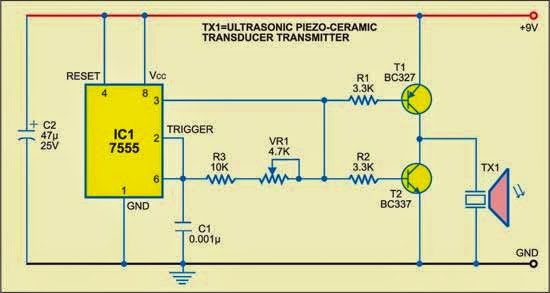
Ultrasonic Transducer Driver Amplifiers
Chip ultrasonic transducer driver and signal conditioner with an advanced DSP core. The device has a complimentary low-side driver pair that can drive a transducer either in a transformer based topology using a step-up transformer or in a direct-drive topology using external high-side FETs. The device can receive and condition the reflected echo.
This paper describes the design of an ultrahigh frequency ultrasound system combined with tightly focused 500 MHz ultrasonic transducers and high frequency wideband low noise amplifier (LNA) integrated circuit (IC) model design. The ultrasonic transducers are designed using Aluminum nitride (AlN) piezoelectric thin film as the piezoelectric element and using silicon lens for focusing. The fabrication and characterization of silicon lens was presented in detail. Finite element simulation was used for transducer design and evaluation. A custom designed LNA circuit is presented for amplifying the ultrasound echo signal with low noise. A Common-source and Common-gate (CS-CG) combination structure with active feedback is adopted for the LNA design so that high gain and wideband performances can be achieved simultaneously. Noise and distortion cancelation mechanisms are also employed in this work to improve the noise figure ( NF) and linearity.
Designed by using a 0.35 μm complementary metal oxide semiconductor (CMOS) technology, the simulated power gain of the echo signal wideband amplifier is 22.5 dB at 500 MHz with a capacitance load of 1.0 pF. The simulated NF at 500 MHz is 3.62 dB.
Introduction Ultrahigh frequency ultrasound has recently been investigated as a tool in the field of microbiology. Applications include acoustic microscopy for the non-invasive investigation of biological tissue and living cells [,,,] and non-contact manipulation of microparticles or cells that are based on radiation force principle [,,]. State of the art in acoustic microscopy is to work with single element focusing transducers. In most cases, the transducers in the ultrahigh frequency range are based on ZnO thin films on sapphire with a grind spherical cavity as a focusing element on the opposite side of the ZnO layer. The attenuation of generated signal in water is proportional to the covered distance and the square of the frequency. With the increasing operation frequency, the focus distance of the transducer should decrease, thus demand smaller radius and higher sphericity of the lens. Makehuman 2 0 updates. When comparing with a sapphire lens for ultrahigh frequency ultrasonic transducer design, a silicon lens might be more appropriate for the following reasons: (1) the silicon wafer is cheaper than the sapphire crystal; (2) good uniformity can be utilized using microelectromechanical systems (MEMS) lithography and etching techniques for the silicon lens rather than the grinding method for the sapphire lens; and, (3) it is possible to make multi lens on a silicon lens body for advanced transducer configurations.
In addition, the signal amplitude of the ZnO based transducer is rather low for a good performance in acoustic microscopy due to the weak piezoelectric behavior. Another important non-ferroelectric piezoelectric material, Aluminum nitride (AlN), possess better chemical and thermal stabilization, better compatibility with the complementary metal oxide semiconductor (CMOS) technology than ZnO [,,]. Furthermore, the much higher longitudinal wave velocity benefits AlN for ultrahigh frequency application. Shows a schematic diagram of an ultrahigh frequency ultrasonic transducer that is based on the silicon acoustic lens. The ultrasound is generated by an AlN thin piezoelectric layer with electrode on both sides.